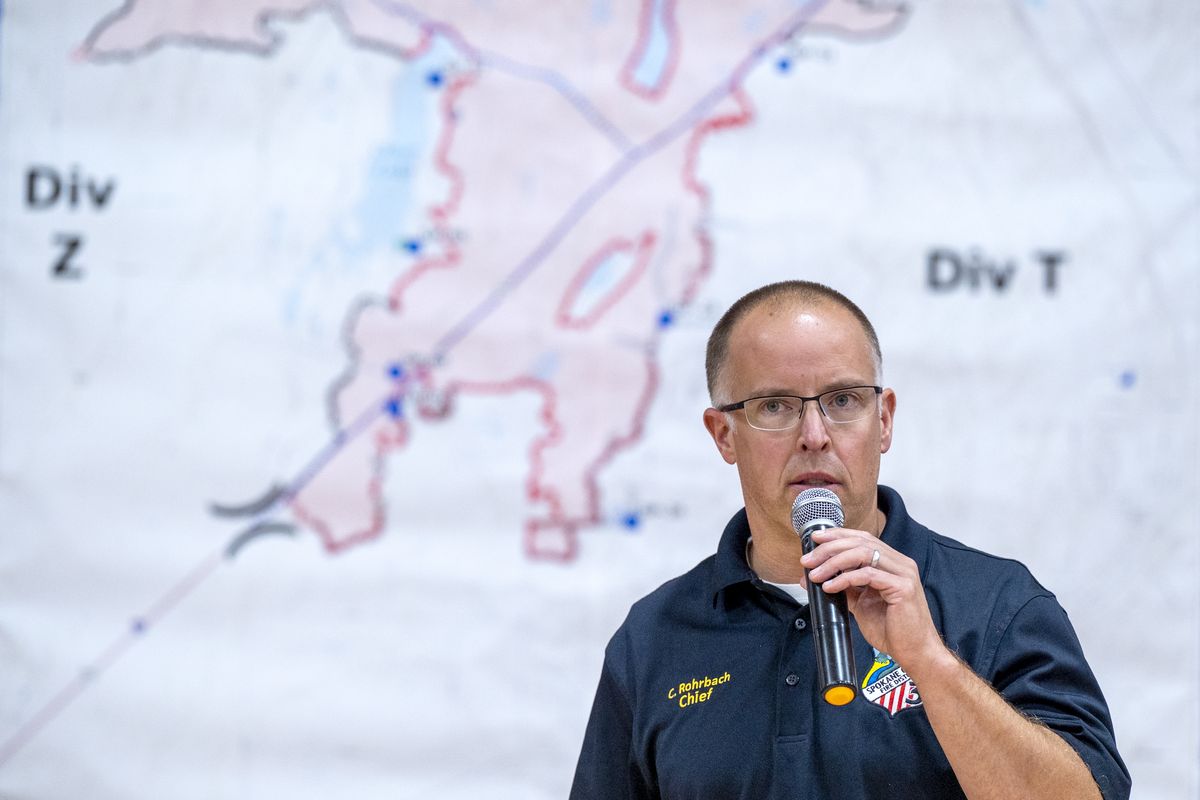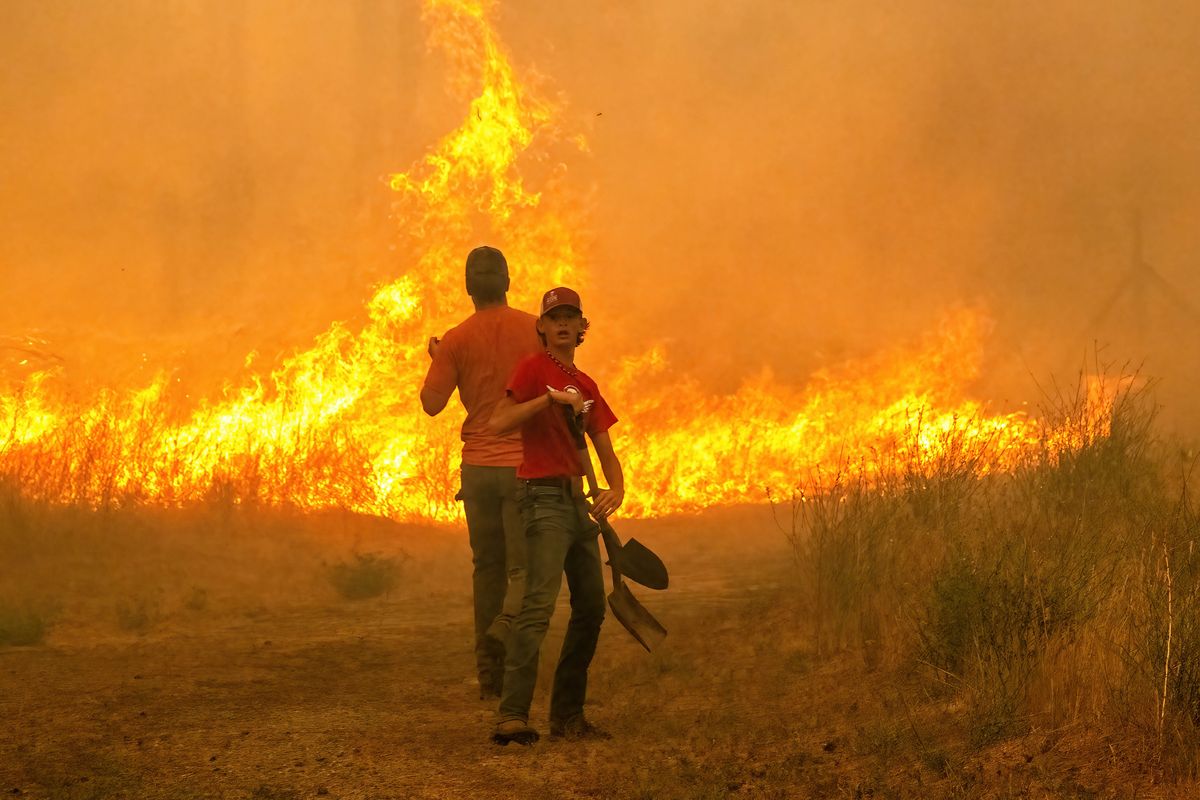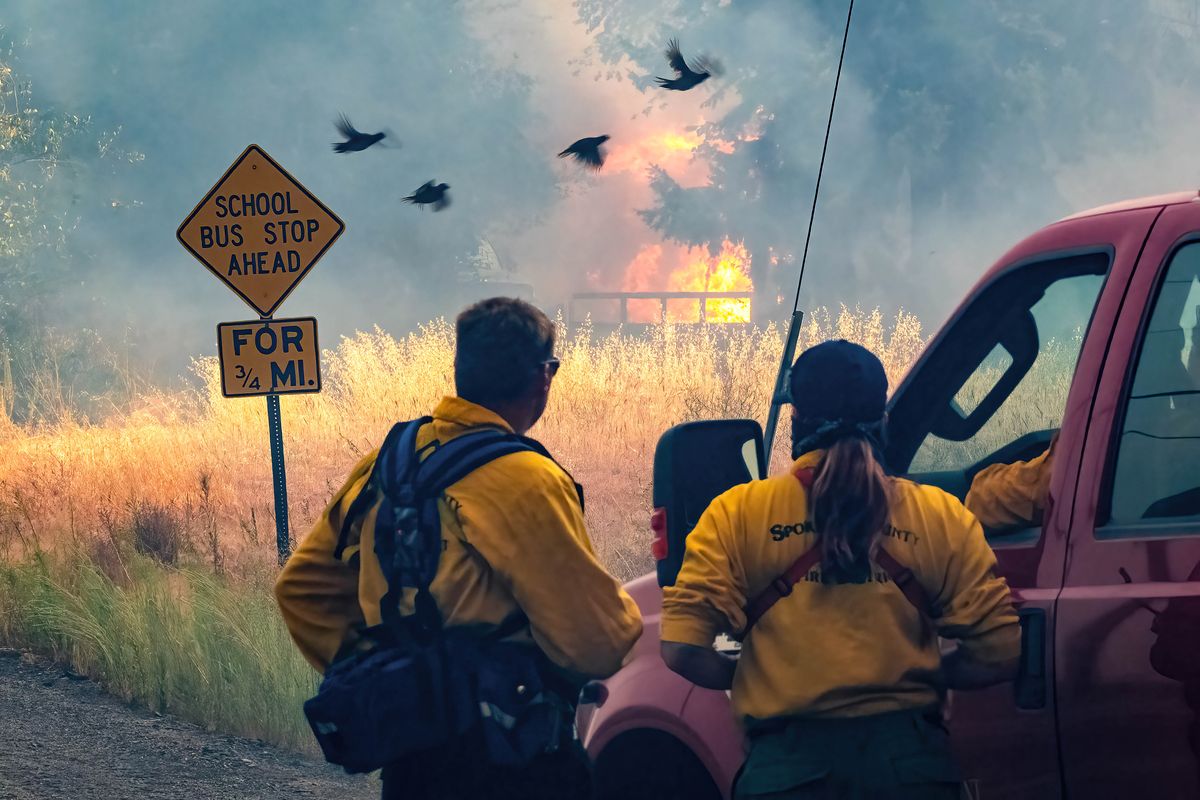Primed for ignition: Fires among Spokane County’s worst natural disasters
After the fire crossed I-90, locals on Granite Lake Road tried to stem the fast-moving flames with shovels. (COLIN MULVANY/THE SPOKESMAN-REVIEW)Buy a print of this photo
The stage was set for fire.
In the 50 days leading up to Aug. 18, Spokane County got nothing more than drizzle – a measly 0.11 inches of rain. It was the hottest week of the year with temperatures repeatedly topping 100 degrees. The winds were unusually strong, too, reaching 37 mph.
“I was dreading coming in that day,” said Daniel Butler, a meteorologist for the National Weather Service in Spokane. “I just had a gut feeling that it wasn’t going to be good.”
Two devastating wildfires, the Gray fire in Medical Lake and the Oregon Road fire northeast of Mount Spokane, broke out that Friday. They’ve burned a collective 21,000 acres, razed 366 homes and consumed 344 other structures.
Individually, they would rank among the most destructive natural disasters in Spokane County history. Combined, they’re the most catastrophic event the county’s seen since the infamous “Firestorm” of October 1991.
Ed Lewis, the incident commander for the Oregon Road fire, remembers “Firestorm” well. He was the chief of Spokane County Fire District 4 at the time and helped fight several of the 92 fires that raged throughout the Inland Northwest, wiping out 114 homes and torching approximately 35,000 acres.
In some ways, Lewis said, “Firestorm” was worse. The winds whipped even harder, exceeding 60 mph. More acres burned, and with fires raging in four counties and two states at once, it was more chaotic. Lewis remembers splitting his firefighters into tiny crews so they could simultaneously battle numerous blazes.
“We basically were out of resources in minutes, and then we had to begin triaging,” he said. “We were simply overran by fire.”
While “Firestorm” was more shocking and remains a vivid memory for many Spokane County residents, it incinerated far fewer homes. The Gray and Oregon Road fires have upended the lives of three times as many families in Medical Lake and near Elk.
The Gray fire began around noon near Gray Road, southwest of Medical Lake. The Washington State Department of Natural Resources is still determining exactly how it got started.
Regardless of what sparked it, the Gray fire began in rolling hills of golden wheat. Based on maps provided by firefighters, its westernmost point appears to have been on farmland owned by the Jensen Memorial Youth Ranch, founded by Carl Grub, 86.
Grub’s body was found Aug. 18 near Medical Lake Waterfront Park, a few miles east of where the fire began. The Spokane County Medical Examiner’s Office hasn’t yet reported how he died.
Strong easterly winds carried the fire over the hills toward Medical Lake. Enormous plumes of pale gray smoke filled the sky as the fire barreled toward town. Residents hastily loaded their cars with valuables, turned on their sprinklers and fled, creating heavy traffic along Lefevre Street and State Highway 902.
“I did see panic today – running around, very frantic,” Medical Lake resident Brian Raska said on the night of Aug. 18.
As the fire reached Ponderosa pines and brush, the smoke grew darker, covering the town in an apocalyptic cloud. The plume blackened once the inferno began chewing up homes and vehicles.
In the early afternoon, dozens of firetrucks and police cars were speeding down Medical Lake streets, attacking the blaze and urging stragglers to evacuate. Helicopters dropped thousands of gallons of water on the fire in an endless loop, hovering over the lake between trips to fill up their massive buckets again and again.
By nightfall, dozens of homes in southern Medical Lake and around Silver Lake were gone. The fire burned all around Granite and Willow lakes, too, and jumped over Interstate 90, forcing the Washington Department of Transportation to close the freeway for several days. As of Aug. 25, the Gray fire had destroyed 240 houses and 86 other structures, such as sheds, shops and barns.
It was a similar story in northern Spokane County as the Oregon Road fire tore through forests and farmland. In some areas the flames soared 200 feet into the sky. The heat was so extraordinary in some spots that not a pine needle was left.
As with the Gray fire, what caused the Oregon Road fire is still under investigation.
Under normal circumstances, the 11,000-acre Oregon Road fire would have been a national news story in its own right.
It started about 3 hours after the Gray fire and, as of Aug. 25, had destroyed 126 homes and 258 other structures. Alex Brown, 49, died in the blaze. The fire has burned roughly parallel to U.S. Highway 2, about 4 miles to the east.
Both fires continue to burn and smolder, but the worst of the damage is done as evacuation orders are eased and lifted and firefighters finish containment lines and hunt for hotspots.
It took four days since the fires were ignited for long-awaited rains to finally arrive. Spokane County received 0.39 inches of precipitation, nearly four times as much as it had received in the previous month and a half.
Firefighters continue mop-up work to ensure the fires don’t cause more damage. More than 1,000 people were working on the Oregon fire on Aug. 25 and another 600-plus were on the Gray fire, many living out of hundreds of tents pitched in a field near Eastern State Hospital.
In some areas of Medical Lake burned by the Gray fire, little remains. A significant portion of the town’s southern end is covered in shapeless piles of black and gray rubble that had been peoples’ homes just a week ago.
Fallen garage doors, violently warped, mark the ends of driveways. A few lonely chimneys still stand, surrounded by nothing but ash. Cars, stripped of their tires, windows and paint, are everywhere, already rusted thanks to Tuesday’s rain.
When Lewis began his career as a firefighter, few if any wildfires ended this way. Before the Hangman Hills fire of 1987 and the “Firestorm” of 1991, losing a significant number of homes in a wildfire was rare.
But the “Firestorm” was a wake-up call, Lewis said. It alerted firefighters to the growing dangers of what they call the wildland urban interface, a zone where homes meet the forest.
In the last 30 years more and more people have built homes in Eastern Washington’s forests, nestled among the pines. Though many of the homes lost in the Gray and Oregon Road fires were situated in neighborhoods, many others were nestled next to or within the trees.
“We continue to populate the urban interface, which makes that environment more complex when we have a fire event,” Lewis said. “Now, virtually every time we respond, we have communities at risk.”





